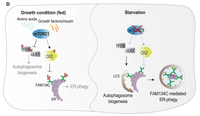Phosphorylation of FAM134C by CK2 controls starvation-induced ER-phagy
Authors: Giorgia Di Lorenzo, Francescopaolo Iavarone, Marianna Maddaluno, Ana Belén Plata-Gómez, Simone Aureli, Camila Paz Quezada Meza, Laura Cinque, Alessandro Palma, Alessio Reggio, Carmine Cirillo, Francesca Sacco, Alexandra Stolz, Gennaro Napolitano, Oriano Marin, Lorenzo A. Pinna, Maria Ruzzene, Vittorio Limongelli, Alejo Efeyan, Paolo Grumati, Carmine Settembre
Year: 2022
Sources: Science Advances
Abstract:
Selective degradation of the endoplasmic reticulum (ER) via autophagy (ER-phagy) is initiated by ER-phagy receptors, which facilitate the incorporation of ER fragments into autophagosomes. FAM134 reticulon family proteins (FAM134A, FAM134B, and FAM134C) are ER-phagy receptors with structural similarities and nonredundant functions. Whether they respond differentially to the stimulation of ER-phagy is unknown. Here, we describe an activation mechanism unique to FAM134C during starvation. In fed conditions, FAM134C is phosphorylated by casein kinase 2 (CK2) at critical residues flanking the LIR domain. Phosphorylation of these residues negatively affects binding affinity to the autophagy proteins LC3. During starvation, mTORC1 inhibition limits FAM134C phosphorylation by CK2, hence promoting receptor activation and ER-phagy. Using a novel tool to study ER-phagy in vivo and FAM134C knockout mice, we demonstrated the physiological relevance of FAM134C phosphorylation during starvation-induced ER-phagy in liver lipid metabolism. These data provide a mechanistic insight into ER-phagy regulation and an example of autophagy selectivity during starvation.
Category: journals

